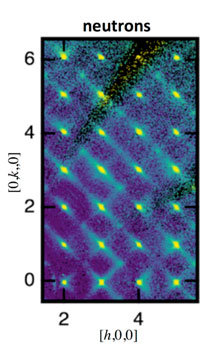| Jul 01, 2019 | |
New insights into long-standing debate about materials that turn motion into electricity(Nanowerk News) For decades, scientists have been intrigued by a class of electronic materials called relaxor ferroelectrics. These lead-based materials can convert mechanical energy to electrical energy and vice versa. The underlying mechanism for this behavior has been elusive. |
|
| The challenge was getting a detailed view of the atomic structure, critical to resolve the debate concerning the role of local order. | |
| Now, novel neutron-based tools and methods have resolved this debate—revealing the relationship of local order motifs and how they affect the underlying properties (Nature Materials, "The relation of local order to material properties in relaxor ferroelectrics"). | |
 Neutron diffuse scattering of relaxor ferroelectrics helped scientists see that the well-known “butterfly” diffuse scattering isn’t symmetrical. This means the intensity of the scattering doesn’t correlate with the material’s ability to return to its equilibrium state, as is the assumption in current models. This result answers long-held questions about relaxor ferroelectrics, which are useful in devices that use sonar and ultrasound. (Image: Argonne National Laboratory) Relaxor ferroelectrics are integral in certain types of computer memory and medical imaging devices. To expand their use in energy production, scientists need to know how the materials work in detail. This study offers a detailed view of the local disorder and its effect. Knowing how structural changes affect properties helps scientists design new materials for energy-relevant uses. In the past, scientists have used different techniques to study relaxor ferroelectrics, such as lead magnesium niobate-lead titanate. However, the techniques couldn’t offer a complete view of the atomic-level structure needed for a comprehensive understanding of these materials. Recent advancements of novel instrumentation and techniques now enable detailed study of the local structure embedded in a crystalline lattice, which is germane to these materials. Using these neutron and synchrotron X-ray scattering methods, researchers determined how local order affects the electromechanical and dielectric properties. The neutron scattering instrument, Corelli, at the Spallation Neutron Source facilitated the measurements of the diffuse neutron scattering that arises from the local structures. Diffuse scattering measurements are particularly sensitive to the departure of the atomic structure from that of a perfect crystal; however, the resultant scattering is generally difficult to quantify because of the wide variety of microstructural effects that may contribute to the signal. The team used complementary neutron and X-ray scattering techniques. Their experiments provided the needed quantitative data and revealed that the local order involves displacements of both the heavy (lead) and light (oxygen) atoms. |
|
| This insight requires revision of current theoretical models that assume light atom displacements are negligible. The combined neutron and synchrotron X-ray investigations revealed that the unique dielectric properties are influenced by the presence of local competing antiferroelectric and ferroelectric order, where the neighboring electric dipole moments are aligned in opposing and parallel directions, respectively. | |
| These results provide important guidelines for developing and evaluating microscopic models that are crucial for the design of the next generation of efficient materials. |
| Source: U.S. Department of Energy, Office of Science | |
|
Subscribe to a free copy of one of our daily Nanowerk Newsletter Email Digests with a compilation of all of the day's news. |
